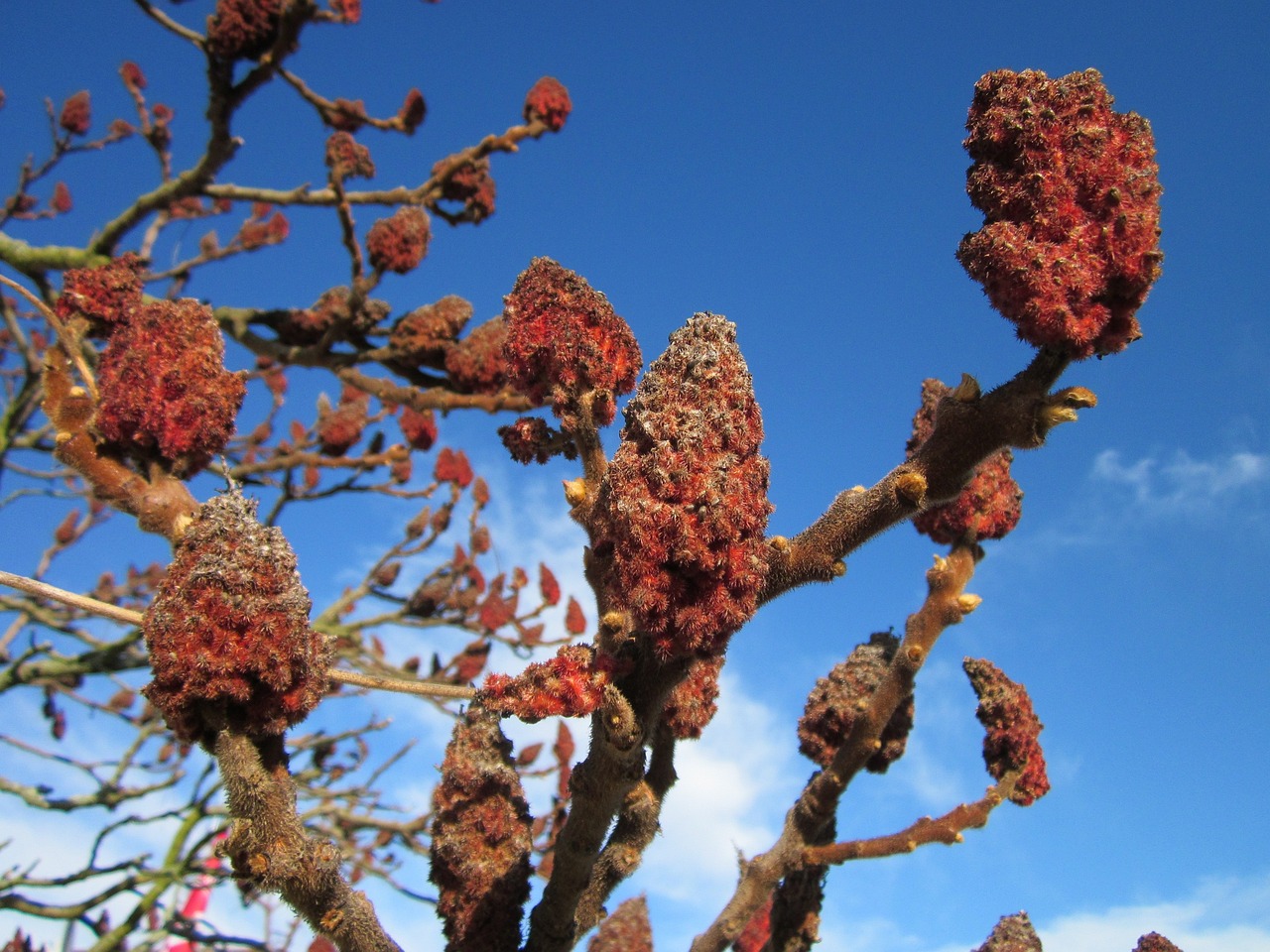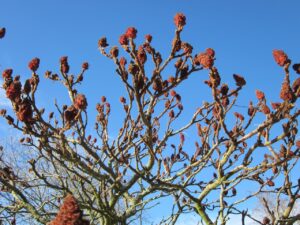Sumac
Overview
Sumac is a versatile herb taken from a small tree or shrub gracing temperate and subtropical regions. This member of the cashew family stands out with vivid autumn colors, clusters of distinctive red berries, and fern-like foliage. It’s esteemed not only for its striking appearance but also for its array of culinary and medicinal uses, making it a fascinating addition to many gardens and spice cabinets around the world.

Characteristics
Known for its fern-like pinnate leaves, striking autumn foliage, and red fuzzy berries.
Region
Temperate and subtropical zones.
Natural Habitat
Sumac is typically found in open fields, rocky hillsides, and woodland edges.
Cultivation
Prefers full sun, well-drained soil, and moderate water.
Uses and Benefits
Sumac’s vibrant red berries are more than a feast for the eyes; they’re a treasure trove of flavor and health benefits too! These tiny but mighty berries are ground into a tangy spice that can add a lemony zing to your favorite dishes. But it doesn’t stop there.
Sumac has been savored not just in the kitchen but also in the medicine cabinet; its components are believed to offer medicinal perks, potentially supporting heart health among other things1. The plant’s versatility extends to industries such as cosmetics and dyeing, where it’s harnessed for its natural compounds2. Whether sprinkled on a hearty meal or utilized as a natural remedy, sumac is surely a herb that deserves a spot in the pantry and possibly in your heart.

Cultivation Tips
Cultivating Sumac (Rhus coriaria) can be a delightful addition to your garden, thanks to its vibrant autumn colors and distinctive red berries. To start, pick a sunny spot because Sumac loves the warmth and light. You’ll also want well-drained soil – although Sumac isn’t too fussy and can adapt to various soil types, good drainage is essential to prevent root rot.
Sumac is quite resilient and doesn’t demand much water. It’s native to environments that are both temperate and subtropical, suggesting it can tolerate some drought. However, keeping the soil moderately moist, especially during dry spells, will help your Sumac thrive. No detailed companion planting guides are available, but given its nature, Sumac should pair well with other drought-tolerant plants. Watch out for pests like scale insects and caterpillars, which may sometimes bother Sumac, but overall, this herb is low-maintenance and hardy5.
Seasonal Considerations
When it comes to seasonal considerations for Sumac, this vibrant plant truly shines during the fall season. As the air turns crisp, Sumac sets the landscape ablaze with its leaves transforming into stunning shades of red, orange, and purple3. This spectacular show of autumnal color isn’t just a feast for the eyes; it’s a signal that the plant’s signature fuzzy red berries are at their peak. These berries, admired for their tangy flavor, are ready to be harvested and can be dried to be used as a spice in various culinary delights1.
It’s also worth noting that since Sumac thrives in temperate and subtropical zones, it’s well-adapted to a range of climates. Gardeners keen to cultivate Sumac should be aware that, while detailed cultivation tips are scarce, ensuring a sunlit spot with a well-balanced water supply could mimic the plant’s native growing conditions for a flourishing shrub5. Consideration of the plant’s dioecious nature is essential for propagation efforts, as you’ll need both male and female plants to produce those aesthetically and culinarily appealing berries4.
Embracing Sumac’s seasonal rhythm can offer gardeners not only a visually enticing autumn display but also a spice that adds a lemony zest to their kitchen creations.

Issues and Troubleshooting
Caring for Sumac isn’t usually an uphill battle, but you might encounter some troubles along the way. Sumac thrives in sun-soaked spots and is quite forgiving when it comes to soil types, but overwatering could lead to root rot—a common misstep with these hardy shrubs. Keep an eye out for signs of distress like yellowing leaves or a general lack of vigor.
Pest infestations are rare but possible; aphids and scale insects sometimes fancy Sumac’s sap, and controlling them might require an eco-friendly soap or oil treatment. Also, be mindful of where you plant Sumac. Its ability to spread via suckers can become problematic, turning a garden favorite into an invader of unwanted spaces. Regular pruning can keep this enthusiasm in check.
Missing the mark on these details could lead to a less-than-vibrant Sumac, but with a touch of care and observation, this plant can be a low-maintenance showstopper in your garden.
History and Folklore
The history of Sumac is as vibrant as its fiery fall foliage. This storied plant, Rhus coriaria, hails from a lineage deeply woven into the fabric of human civilization. Sumac has graced Middle Eastern tables for centuries — its tangy, crimson berries crushed and sprinkled onto food as a zestful spice5. Beyond the kitchen, it has been revered in traditional medicines, valued for its supposed healing properties2. In the realm of folklore, Sumac’s bold presence is often seen as a symbol of life and vitality, a natural talisman believed to ward off negative energies. The striking red of its berries captures the imagination, evoking tales of ancient dye-makers who turned its rich color into stunning textiles. The threads of Sumac’s history and myth intertwine, painting a picture of a plant deeply rooted in cultural heritage.
References
1. Healthline. “Sumac: Benefits, Uses, and Forms,” https://www.healthline.com/nutrition/sumac-benefits-uses-and-forms
2. ScienceDirect. “Sumac: a functional food and herbal remedy in traditional herbal,” https://www.sciencedirect.com/science/article/pii/B9780128198155000185
3. Leafyplace. “Sumac Trees: Types, Leaves, Berries (Pictures) – Identification Guide,” https://leafyplace.com/sumac-trees/
4. Wikipedia. “Sumac,” https://en.wikipedia.org/wiki/Sumac
5. Britannica. “Sumac | Description & Examples,” https://www.britannica.com/plant/sumac
Image Credit: WikimediaImages
Image Credit: WikimediaImages
Image Credit: Hans
Nicolas Duval
Nicolas is a passionate advocate for nature and the art of wildcrafting. His dedication shines through in Wildcraftia, a website he meticulously crafted to serve as a haven for nature enthusiasts worldwide. Driven by a deep appreciation for nature’s connection to humanity, Nicolas embarked on his journey in 2011 with SmokableHerbs, a platform showcasing his love for nature’s bounty. Building upon this foundation, he established Smokably, a thriving online store offering premium herbs and blends to a global audience.
